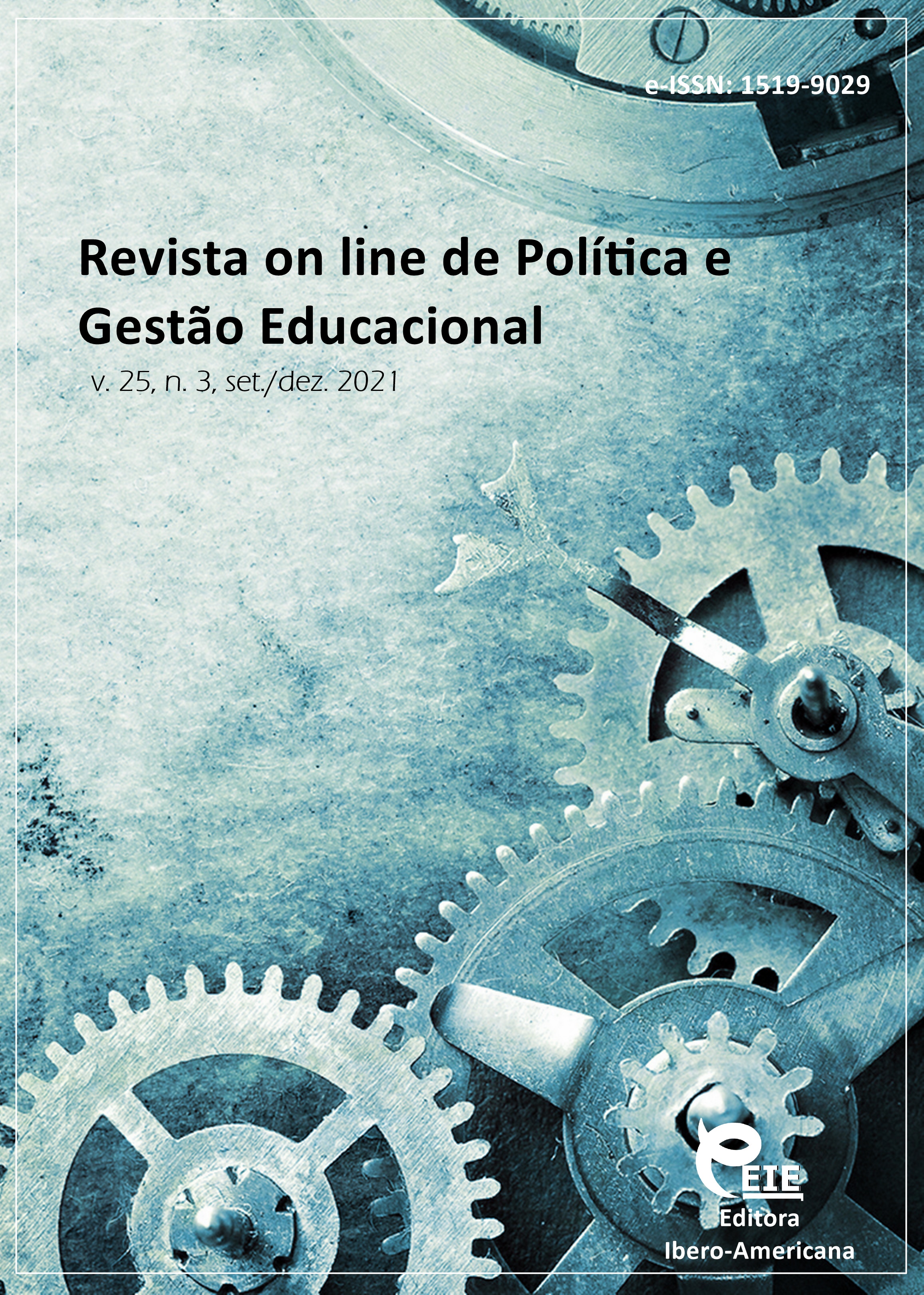Peculiaridades del desarrollo de la enseñanza superior en un entorno de aprendizaje mixto
DOI:
https://doi.org/10.22633/rpge.v25i3.15959Palabras clave:
Pedagogía, Aprendizaje combinado, EntornoResumen
Este artículo pretende identificar las peculiaridades de la transformación de la pedagogía de la enseñanza superior a través del modelo de aprendizaje mixto. La metodología se basó en un análisis estadístico y correlacional utilizando la base de datos de la Encuesta Internacional de Enseñanza y Aprendizaje, que contiene los resultados de la encuesta realizada a 7.823 educadores de Francia y los Países Bajos. Resultados. El estudio reveló un nivel medio de preparación de los profesores para el aprendizaje mixto (50,5%) y de preparación para el uso de las TIC en el aprendizaje de los alumnos (48,4%) componentes de inclusión. Se reveló un nivel significativo de desarrollo profesional de los profesores en cuanto a las competencias en TIC (el 44% realiza cursos). Se estableció un nivel medio de falta de preparación de los profesores tanto para el aprendizaje combinado (28,9% no está preparado, 36,6% no está suficientemente preparado) como para el uso de las TIC en la práctica (30,3% - casi no está preparado, 34,25 - no está suficientemente preparado). Se estableció una correlación positiva entre la preparación de los profesores para el entorno de aprendizaje combinado y el paso de los cursos de desarrollo de habilidades profesionales en TIC.
Descargas
Citas
ARNESEN, K. T. et al. Experiences with Personalized Learning in a Blended Teaching Course for Preservice Teachers. Journal of online learning research, Waynesville, v. 5, n. 3, p. 275-310, 2019. Available: https://www.learntechlib.org/primary/p/210637. Access: 5 Dec. 2021.
ARNEY, L. Go blended!: A handbook for blending technology in schools. Hoboken: John Wiley & Sons, 2014.
BORUP, J. et al. Academic Communities of Engagement: an expansive lens for examining support structures in blended and online learning. Educational Technology Research and Development, Chestnut Hill, v. 68, n. 2, p. 807-832, 2020. DOI: https://doi.org/10.1007/s11423-020-09744-x
DZIUBAN, C. et al. Blended learning: the new normal and emerging technologies. International Journal of Educational Technology in Higher Education, Barcelona, v. 15, n. 1, p. 1-16, 2018. DOI: https://doi.org/10.1186/s41239-017-0087-5
GRAHAM, C. R. Blended learning models. In: KHOSROW-POUR, M. Encyclopedia of Information Science and Technology. 2. ed. Pennsylvania: IGI Global, 2009. p. 375-382. DOI: https://doi.org/10.4018/978-1-60566-026-4.ch063
GRAHAM, C. R. Current research in blended learning. In: Handbook of distance education. England: Routledge, 2013a. p. 173-188.
GRAHAM, C. R. Emerging practice and research in blended learning. In: Handbook of distance education. England: Routledge, 2013b. p. 351-368.
GRAHAM, C. R. et al. K–12 Blended Teaching Readiness: Model and Instrument Development. Journal of Research on Technology in Education, Gainesville, v. 51, n. 3, p. 239-258, 2019. DOI: https://doi.org/10.1080/15391523.2019.1586601
HRASTINSKI, S. What do we mean by blended learning? TechTrends, Statesboro, v. 63, n. 5, p. 564-569, 2019. DOI: https://doi.org/10.1007/s11528-019-00375-5
LÓPEZ-PÉREZ, M. V.; PÉREZ-LÓPEZ, M. C.; RODRÍGUEZ-ARIZA, L. Blended learning in higher education: Students’ perceptions and their relation to outcomes. Computers & Education, Tempe, v. 56, n. 3, p. 818-826, 2011. DOI: https://doi.org/10.1016/j.compedu.2010.10.023
MANWARING, K. C. et al. Investigating student engagement in blended learning settings using experience sampling and structural equation modeling. The Internet and Higher Education, Hong Kong, v. 35, p. 21-33, 2017. DOI: https://doi.org/10.1016/j.iheduc.2017.06.002
MOSKAL, P.; DZIUBAN, C.; HARTMAN, J. Blended learning: A dangerous idea? The Internet and Higher Education, Hong Kong, v. 18, p. 15-23, 2013. DOI: https://doi.org/10.1016/j.iheduc.2012.12.001
ORGANISATION FOR ECONOMIC COOPERATION AND DEVELOPMENT. TALIS 2018 Results (Volume I): Teachers and School Leaders as Lifelong Learners. Paris: OECD Publishing, 2019. DOI: https://doi.org/10.1787/1d0bc92a-en
PORTER, W. W. et al. Blended learning in higher education: Institutional adoption and implementation. Computers & Education, Tempe, v. 75, p. 185-195, 2014. DOI: https://doi.org/10.1016/j.compedu.2014.02.011
PORTER, W. W. et al. A qualitative analysis of institutional drivers and barriers to blended learning adoption in higher education. The internet and Higher education, Hong Kong, v. 28, p. 17-27, 2016. DOI: https://doi.org/10.1016/j.iheduc.2015.08.003
PULHAM, E.; GRAHAM, C. R. Comparing K-12 online and blended teaching competencies: a literature review. Distance Education, London, v. 39, n. 3, p. 411-432, 2018. DOI: https://doi.org/10.1080/01587919.2018.1476840
PULHAM, E.; GRAHAM, C.; SHORT, C. Generic vs. Modality-Specific Competencies for K-12 Online and Blended Teaching. Journal of Online Learning Research, Waynesville, v. 4, n. 1, p. 33-52, 2018. Available: https://files.eric.ed.gov/fulltext/EJ1174455.pdf. Access: 5 Dec. 2021.
SMITH, K.; HILL, J. Defining the nature of blended learning through its depiction in current research. Higher Education Research & Development, Hobart, v. 38, n. 2, p. 383-397, 2019. DOI: https://doi.org/10.1080/07294360.2018.1517732
SPRING, K. J.; GRAHAM, C. R.; HADLOCK, C. A. The current landscape of international blended learning. International Journal of Technology Enhanced Learning, Geneva, v. 8, n. 1, p. 84-102, 2016. DOI: https://doi.org/10.1504/IJTEL.2016.075961
VAUGHAN, N. Perspectives on Blended Learning in Higher Education. International Journal on E-learning, Waynesville, v. 6, n. 1, p. 81-94, 2007. Available: https://eric.ed.gov/?id=EJ747810. Access: 5 Dec. 2021.
Publicado
Cómo citar
Número
Sección
Licencia
Derechos de autor 2021 Revista on line de Política e Gestão Educacional

Esta obra está bajo una licencia internacional Creative Commons Atribución-NoComercial-CompartirIgual 4.0.
Manuscritos aceitos e publicados são de propriedade da Revista on line de Política e Gestão Educacional. É vedada a submissão integral ou parcial do manuscrito a qualquer outro periódico. A responsabilidade do conteúdo dos artigos é exclusiva dos autores. É vedada a tradução para outro idioma sem a autorização escrita do Editor ouvida a Comissão Editorial Científica.










